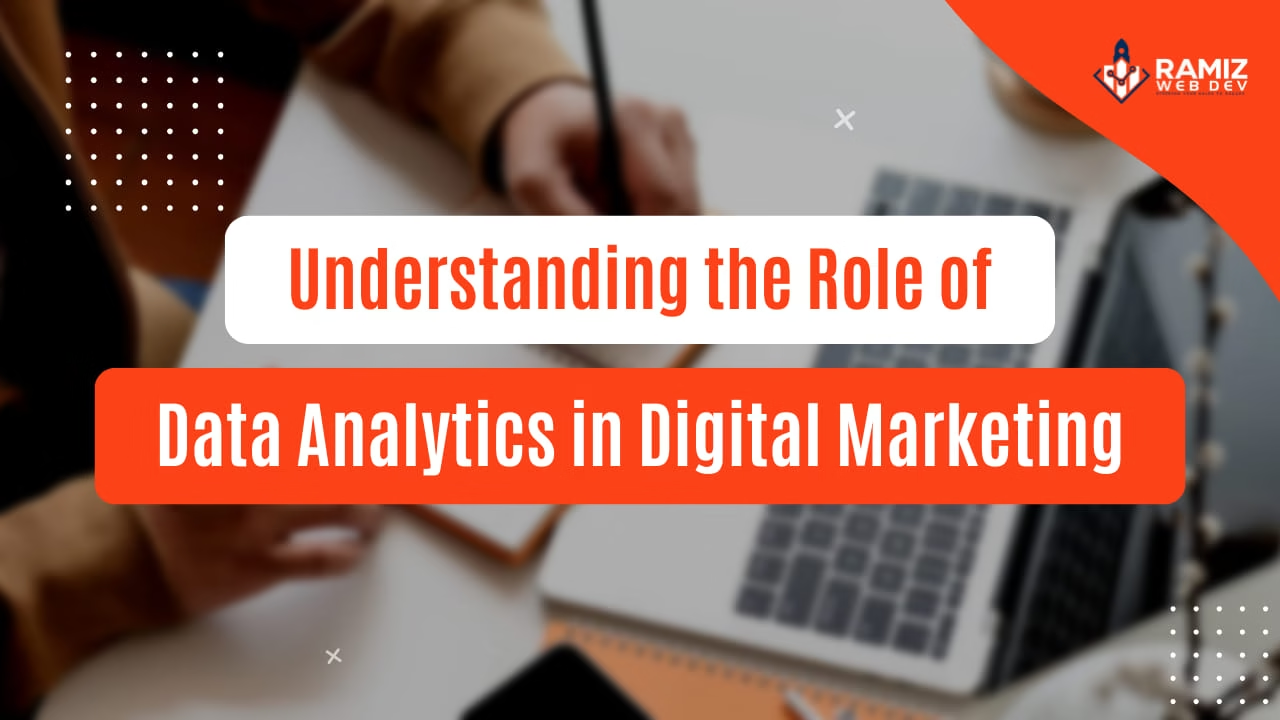In today’s highly competitive digital landscape, businesses are constantly striving to gain an edge over their competitors. One of the most powerful tools available for achieving this goal is data analytics. By utilizing data-driven insights, businesses can make more informed decisions, enhance their digital marketing efforts, and ultimately boost their bottom line. In this article, we will explore the significance of data analytics in digital marketing, its benefits, and how businesses can effectively leverage it to achieve their marketing objectives.
What is Data Analytics in Digital Marketing?
Data analytics refers to the process of collecting, organizing, and analyzing large sets of data to uncover patterns, trends, and insights that can drive decision-making. In the context of digital marketing, data analytics involves analyzing consumer behavior, campaign performance, website traffic, social media interactions, and much more.
The power of data analytics lies in its ability to provide actionable insights. These insights help businesses understand customer preferences, improve targeting, optimize campaigns, and measure the effectiveness of marketing strategies. By using data analytics, digital marketers can make data-backed decisions rather than relying on guesswork or intuition.
The Importance of Data Analytics in Digital Marketing
In today’s data-driven world, traditional marketing methods that rely on broad assumptions are becoming less effective. Consumers are more connected than ever before, and their behavior is constantly evolving. To keep up with these changes, businesses must harness the power of data analytics. Here’s why data analytics is crucial for digital marketing success:
1. Improved Decision Making
Data analytics empowers marketers to make better decisions by providing real-time insights into consumer behavior and market trends. For example, by analyzing website data, marketers can identify which pages are performing well and which ones need improvement. This allows them to make data-driven decisions about website design, content strategy, and more.
2. Enhanced Targeting and Personalization
One of the greatest advantages of data analytics is the ability to segment and target specific customer groups more effectively. By analyzing customer demographics, interests, and online behaviors, businesses can create personalized marketing campaigns that resonate with individual customers. Personalization leads to higher engagement, increased conversions, and improved customer satisfaction.
3. Optimized Marketing Campaigns
Data analytics helps marketers track the performance of their campaigns in real time. By analyzing key performance indicators (KPIs) such as click-through rates (CTR), conversion rates, and return on investment (ROI), marketers can identify which aspects of their campaigns are working and which ones need adjustment. This allows for continuous optimization and better allocation of marketing resources.
4. Enhanced Customer Insights
Understanding your customers is key to delivering products and services that meet their needs. Data analytics provides deep insights into customer preferences, pain points, and purchasing behavior. This information can be used to refine product offerings, improve customer experiences, and foster stronger relationships with your audience.
5. Predictive Analytics for Future Trends
Another powerful aspect of data analytics is the ability to predict future trends and behaviors. By analyzing historical data, marketers can forecast customer actions, market shifts, and industry changes. This allows businesses to stay ahead of the curve and proactively adjust their marketing strategies to align with future demands.
Key Types of Data Analytics in Digital Marketing
There are several different types of data analytics that marketers can use to enhance their digital marketing strategies. Each type serves a unique purpose and provides valuable insights for optimizing marketing efforts. Here are the main types of data analytics used in digital marketing:
1. Descriptive Analytics
Descriptive analytics focuses on understanding what has happened in the past. By analyzing historical data, marketers can gain insights into trends and patterns that can inform future strategies. For example, descriptive analytics can be used to track website traffic, measure the effectiveness of past marketing campaigns, and understand customer behaviors over time.
2. Diagnostic Analytics
Diagnostic analytics goes a step further by seeking to understand why something happened. For example, if a marketing campaign underperformed, diagnostic analytics can help determine the root cause of the issue. Was it poor targeting, a lack of engagement, or an issue with the product itself? By identifying the reasons behind a marketing failure, businesses can adjust their approach and improve their strategies moving forward.
3. Predictive Analytics
Predictive analytics uses historical data and machine learning algorithms to predict future outcomes. This type of analytics is used to forecast trends, anticipate customer behavior, and identify potential opportunities or challenges. Predictive analytics can be particularly useful for demand forecasting, lead scoring, and predicting the success of upcoming marketing campaigns.
4. Prescriptive Analytics
Prescriptive analytics goes beyond predicting what will happen by recommending actions that businesses should take to achieve their desired outcomes. For example, based on data insights, prescriptive analytics may recommend changes to a marketing strategy, suggest specific content topics, or identify the best channels for reaching target audiences.
How to Leverage Data Analytics in Digital Marketing?
Now that we’ve explored the importance and different types of data analytics, let’s dive into how businesses can effectively leverage data analytics in their digital marketing efforts. Here are several actionable steps for getting the most out of your data:
1. Set Clear Goals and KPIs
Before diving into data analytics, it’s essential to define clear marketing goals and KPIs. What are you trying to achieve with your digital marketing efforts? Are you aiming to increase website traffic, generate more leads, or boost online sales? Setting specific, measurable goals will help you focus your analytics efforts and ensure that you’re tracking the right data.
2. Utilize Analytics Tools
To make sense of all the data at your disposal, you’ll need the right tools. There are a variety of analytics platforms available, such as Google Analytics, HubSpot, and Adobe Analytics, that can help you collect and analyze data. These tools provide detailed insights into website traffic, user behavior, conversion rates, and more.
3. Segment Your Audience
One of the most powerful ways to use data analytics in digital marketing is by segmenting your audience based on demographics, interests, and behaviors. By grouping your audience into smaller, more targeted segments, you can create personalized marketing campaigns that are more likely to resonate with each group.
4. Monitor Campaign Performance
Regularly monitor the performance of your marketing campaigns using analytics tools. Track KPIs such as conversion rates, engagement levels, and customer acquisition costs. This will help you identify which campaigns are driving results and which ones need optimization.
5. Test and Optimize Continuously
Data analytics provides marketers with the ability to conduct A/B tests, experiment with different marketing strategies, and continuously optimize campaigns. By analyzing the results of these tests, you can refine your approach and improve your marketing performance over time.
The Challenges of Data Analytics in Digital Marketing
While data analytics can provide significant benefits, it is not without its challenges. Some of the key challenges businesses face when using data analytics in digital marketing include:
1. Data Overload
With so much data available, it can be overwhelming for marketers to sift through and find the insights that matter most. It’s important to focus on the data that directly aligns with your goals and KPIs to avoid getting lost in a sea of information.
2. Data Quality
The accuracy and quality of the data you collect are critical to making informed decisions. Poor-quality data can lead to inaccurate insights, which can negatively impact your marketing strategies. To overcome this challenge, it’s essential to implement data validation processes and ensure that your data is clean and reliable.
3. Lack of Expertise
Data analytics requires a certain level of expertise, and not all marketing teams have the necessary skills to analyze data effectively. To overcome this challenge, businesses can invest in training their teams or work with data analytics professionals to ensure that they are leveraging data to its full potential.
Conclusion
In conclusion, data analytics is a game-changer for digital marketing. It allows businesses to make more informed decisions, optimize their marketing campaigns, and deliver personalized experiences that resonate with their audience. By leveraging the power of data, businesses can stay ahead of the competition and achieve measurable results.
As the digital landscape continues to evolve, the role of data analytics in digital marketing will only become more critical. Marketers who embrace data-driven decision-making will be better equipped to navigate the complexities of the digital world and drive long-term success. Thus, whether you’re just getting started with data analytics or looking to enhance your current strategy, now is the time to take advantage of this powerful tool.








